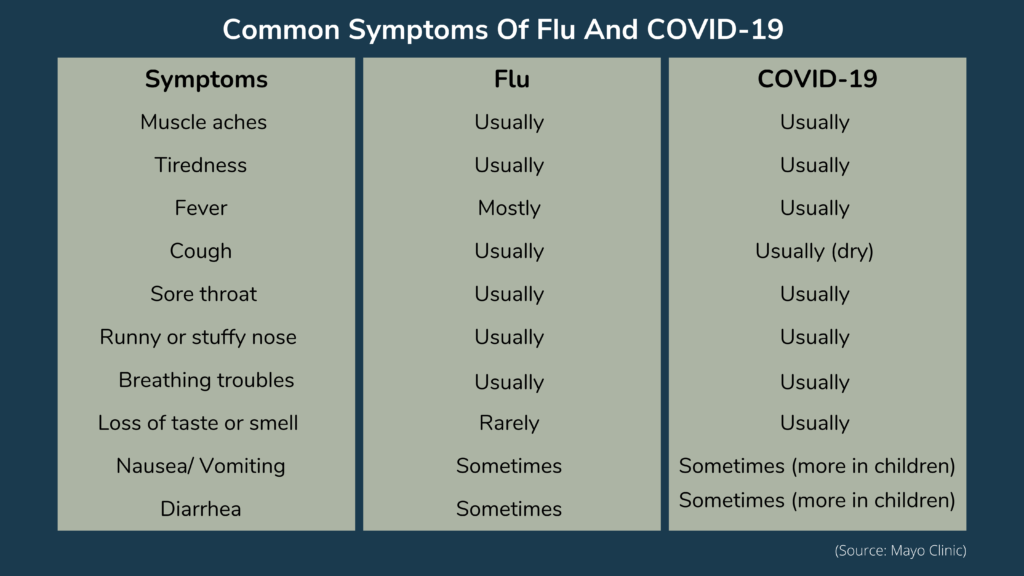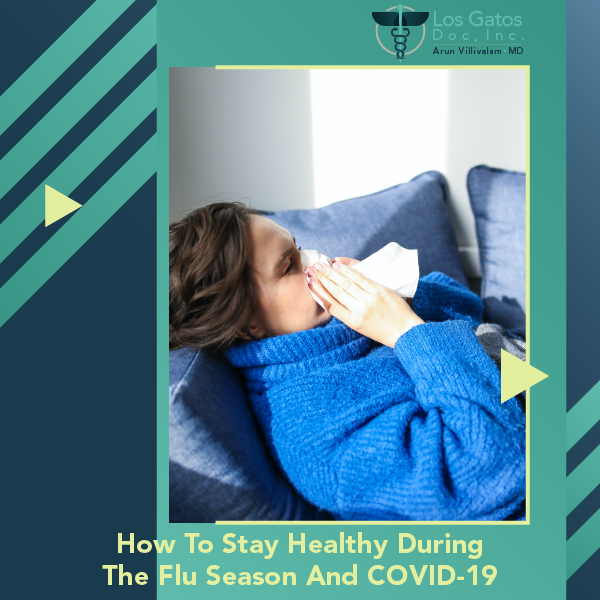The upcoming fall and winter months bring forth the flu season amid a raging global pandemic this year. Currently, we are experiencing the fourth wave of the coronavirus because of the Delta variant.
The flu cases were notably lower in 2020-21. The Centers for Disease Control and Prevention (CDC) reported that between September 28th, 2020, and May 22nd, 2021, only 0.2% of the 818,939 samples tested in U.S. laboratories were positive for the influenza virus.
Last year, the “unusually low” cases of flu were attributed to universal masking, social distancing, hand hygiene, global lockdowns, and restricted international travel.
However, experts speculate that this year with the easing of COVID-19 restrictions and rising cases, there may be an upsurge in flu infections, causing a greater burden on our healthcare system.
Let’s discuss how we can prepare for the upcoming fall and winter flu season amid the COVID-19 pandemic this year.
How Can You Tell If You Have The Flu Or COVID-19?
Both the flu (influenza) and COVID-19 are contagious respiratory diseases with potentially threatening consequences.
- According to the World Health Organization (WHO) estimates, 290,000-650,000 people die of flu-related causes every year worldwide.
- The COVID-19 pandemic is still prevalent, and its estimated mortality rate is speculated to be 10x than most strains of the flu.
The flu and COVID-19 have similar symptoms and transmission. But they are caused by different viruses. The flu is caused by the influenza viruses while the SARS-CoV-2 virus causes COVID-19.
The flu and COVID-19 spread in similar ways where smaller virus droplets from the sick person linger in the air and spread to others via inhalation, touching surfaces and their face. COVID-19 spreads much more widely and quickly than the flu, thereafter resulting in continuous spreading among people.
People may not be aware that they have contracted the flu or COVID-19 and spread it to others in their family and communities.
Knowing if you have the flu or COVID-19 can help you avoid transmitting it to others.
According to Mayo Clinic, some common symptoms of the flu and COVID-19 as updated on Sept. 08, 2021,

The symptoms of flu can appear anywhere between 1-4 days after contracting the influenza virus. COVID-19 symptoms take 2-14 days to appear after exposure to SARS-CoV-2. You are more contagious for a longer time if you have COVID-19 than the flu.
Both the diseases can cause nil to mild to severe symptoms. It can be challenging to tell which of the two conditions you might have. You may need diagnostic testing to detect the exact condition. You can have both the flu and COVID-19 at the same time.
Both the conditions can have serious, long-term complications and even fatal consequences, including pneumonia, acute respiratory distress syndrome, heart attack, brain stroke, organ failure, and death.
If you have signs or symptoms of the flu or COVID-19, it’s vital to consult Los Gatos Doc, for medical advice.
How To Stay Healthy During The Flu Season Amid COVID-19
A quick note is to remember that the steps to prevent the spread of COVID-19 are similar to help prevent the spread of the flu.
Our top suggestions to you would be to:
- Follow the latest CDC, state, and local public health department guidelines on COVID-19 safety measures.
- Wear a mask in indoor public places and outdoors where the risk of transmission is high
- Avoid crowded, especially indoor spaces.
- Socially distance as much as possible (within 6 feet), especially if you have a higher risk of serious illness
- Practice good hand hygiene
- Cover your nose and mouth with your elbow or a tissue when you sneeze or cough
- Avoid touching your eyes, nose, and mouth
- Clean and disinfect high-touch surfaces in your home daily
- Get your COVID-19 vaccine and annual flu shot.
- Stay home when sick and get tested
These simple but effective tips can help prevent and manage the flu and the coronavirus.
Particularly, we cannot stress enough the importance of vaccinations. Vaccines have played a huge role in eradicating and containing some of the deadliest diseases in the history of humankind, improving our health and mortality rate.
Since they are administered to millions of people, including children, vaccines are held up to very high safety standards and undergo several years of safety testing before getting licensed by the Food and Drug Administration (FDA) and recommended for use by the Centers for Disease Control and Prevention (CDC).
Vaccines strengthen our immune system, preventing serious diseases and reducing hospitalization and death in individuals and communities.
We can all help prevent the spread of diseases, including the flu and the coronavirus, by getting our vaccinations.
Vaccines can also help avoid placing our healthcare systems under a great burden.
If you’re fully vaccinated against COVID-19, you can return to most activities that you have been doing before the pandemic unless required by the law.
Getting your annual flu vaccination is equally important. It can be a serious condition, especially for children, older adults, and impaired immune systems. The flu viruses are constantly changing, and the vaccine composition is reviewed and updated accordingly.
Final Thoughts
Our world is gripped by the double threat of the flu and COVID-19 this year. We can take proactive measures to follow the recommended health and safety practices to protect ourselves, our families, and our communities.
If you have any queries on the flu, coronavirus, and vaccinations, please contact Los Gatos Doc, Los Gatos family physician, at 408-520-6040 or schedule a visit at visitlosgatosdoc.com.
Disclaimer: We routinely draw upon public health resources to inform our write-ups. Information in this article may be drawn up from multiple public health sources, including:
- Centers for Disease Control & Prevention
- Medline Plus
- National Institutes of Health
- American Medical Association
- American Association of Family Physicians
- Mayo Clinic
- Family Doctor






